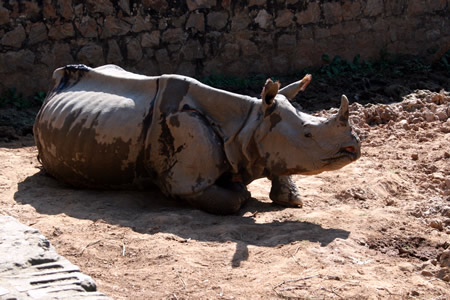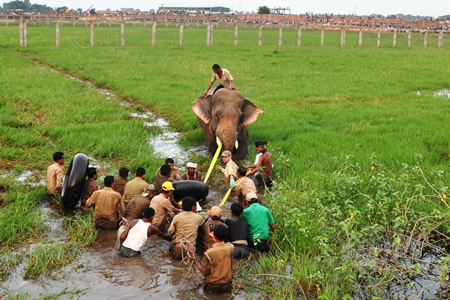Away from home: Journey of a rhino
Kaziranga National Park (Assam), October 29, 2012: Many wild animals end up getting displaced, stranded or injured due to man-made reasons or natural causes, rendering their chances of returning to their natural territory very slim. For the past ten years, the Centre for Wildlife Rehabilitation and Conservation (CWRC) run by Assam Forest Department and International Fund for Animal Welfare – Wildlife Trust of India (IFAW-WTI) has been rescuing and rehabilitating these animals. We have saved more than 1500 individual animal lives till date.
Of all these rescues, the most difficult that I have personally been a part of, took place recently. It was a strange case. Local fishermen reported a rhino in an uninhabited island in the Brahmaputra river on September 30. The nearest bank was at least a kilometre away, so we were naturally perplexed as to how it managed to reach here. The only logical explanation was that the rhino may have been washed in by the floods from Pobitora Wildlife Sancutary, which is about 50 km upstream.
The gravity of this unusual case of displacement and the need for intervention was obvious. If the rhino decided to travel further, and did manage to reach the bank somehow, it would have ended up in heavily human-dominated areas. This would not only endanger the people living there but also the animal itself.
The rescue operation
With many rhinos having been poached in the floods or having lost the fight against nature, rescuing it was a priority for the state authorities. Uniting conservationists including rescue team members from CWRC, WWF-India, Assam Elephant Foundation as well as vets from College of Veterinary Sciences, Guwahati, the Forest Department took the lead in the operation.
A quick survey of the situation by the team showed that the rhino was taking shelter in an area with quick sand, receiving heavy rain and with the flooded river flowing right next to it. So it was not possible for us to be on foot. Immediate tranquilisation was ruled out as the site was not favourable, and it could be unsafe as the animal was under stress and exhausted.
However, preparations began. Talks were held with the Indian Air Force, who volunteered to spare a helicopter to fly the rhino to safety once the situation on ground improved. Experts from South Africa were consulted. With all preparations done, the team waited for the weather to improve, the rain to let up, and the sand to dry up a bit to attempt tranquilisation and airlifting (which had it happened, would have been the first of its kind case in India).
It was a daunting task – to keep the animal safe and rescue it successfully. However, the team was determined to see through this challenge. The state Forest Minister visited the site, interacted with the team members to take stock of the situation, and ensured protection to the rhino from lurking poachers while the team prepared its rescue.
Five days after the rescue preparations began, on October 5, the rain stopped. The rhino now seemed more active and stable. A day later, the ground situation was improving, and a decision was taken to carry out the operation as soon as it was suitable. However, the rhino it appears had its own plans.
On October 7, we got a call from the DFO – Guwahati Wildlife Division, informing that the rhino had crossed the Brahmaputra and reached a settlement adjoining the Guwahati Airport! We rushed to the site and found the animal in a wetland, with thousands of onlookers already ‘holding their seats’.
Heavy machinery and equipment, like a crane, crate and JCB machine, were immediately called in from the nearest storage units which were 45 km away. By the time the equipment arrived, only an hour of daylight was left at the team’s disposal. A few captive elephants had also been brought in to help in the rescue.
Still, tranquilisation posed a problem; it is against the protocol to tranquilise an animal in the wetlands, as that heightens the risk of the animal drowning. However with the ground situation already too risky, we had no alternative. The Forest Minister got the state’s Chief Minister to approve the rescue.
Wasting no time, the team immediately jumped into the water and darted the rhino. To save the rhino from drowning, three truck tyre tubes were used to keep it afloat. With the help of a tractor and elephants, the rhino was placed on a wooden sledge for transportation. Carefully, the sledge was pulled to the bank of the wetland where the JCB machine was then used to transport the rhino to the crate by main road, amidst the crowd of a thousand people. After almost two intense hours, the rescue team was at last able to relax, once the rhino was finally put in the crate and the sedation was reversed.
The rhino turned out to be a full grown adult female with some external injuries which could have happened during its odious journey. She was taken to the Assam State Zoo and released in a paddock there, ending the 18-hour long operation.











